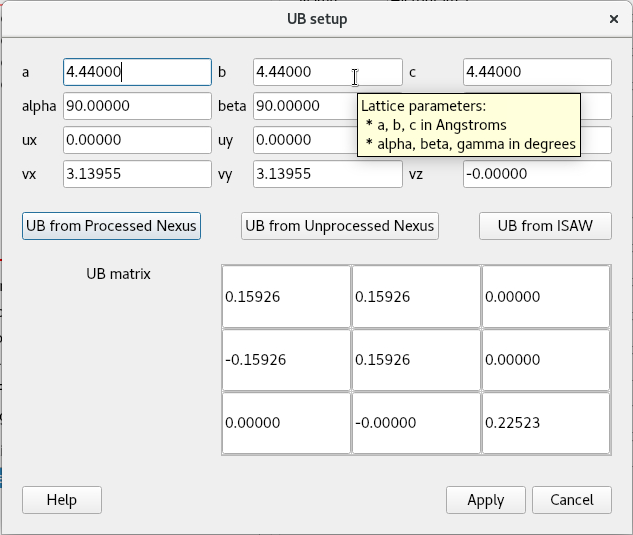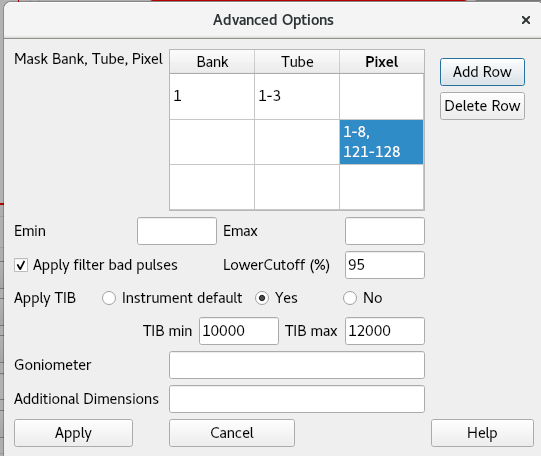Sample parameters
This dialog box allows setting/ modifying the lattice parameters and sample orientation (the UB matrix). There are two ways to specify these:
- The
a,b,c,alpha,beta,gammaare the lattice parameters. When the goniometer angles are all zero, the orientation vectoru = (ux, uy, uz)points along the beam, and thev = (vx, vy, vz)vector is in the horizontal plane, not necessarily perpendicular tou, in a way that the cross product points upward. - The
UBmatrix. A good explanation can be found in the Mantid concepts page
One can also load these parameters from the raw file, a processed nexus file, or an ISAW UB matrix file.

Polarization options
For polarized neutron experiments, it is useful to label the data with the polarization state:

The state it used as a suggestion when selecting data.
If both polarization states are selected in the main window, the Flipping ratio
and Flipping ratio sample log parameters are passed to the
FlippingRatioCorrectionMD algorithm, so in the end one ends up with flipping ratio corrected histograms.
For the HYSPEC instrument, when using the supermirror polarization analyser, the neutron will be deflected by
a small amount, the PSDA (polarization supermirror deflection angle). This needs to be
taken in consideration when generating the MD event data. By default, this
value is taken from the file, so leave this field empty. If you want to override, 0.0 is unpolarized,
and -1.3 is for the polarized state.
Advanced reduction options
When generating multi-dimensional event data sets, there are some advanced options available:

- In addition to the mask file in the Generate tab, one can mask
additional detectors. Each line in the
Mask Bank, Tube, Pixelis used independently. So in the example in the figure, tubes 1, 2, and 3 in the first bank are masked, followed by masking pixels 1 to 8 and 121 to 128 in every bank, in every tube. - The
EminandEmaxdefine the energy transfer range, in meV. The default values are -0.95 and +0.95 times the incident energy - The pulses with low proton charge can be filtered out using the
Apply filter bad pulsesflag, where neutrons coming from pulses with charge less thanLower cutoff (%)of the median pulse charge will be ignored - One can subtract a time independent background. If
Instrument defaultoption is used, there is no such subtraction for ARCS or SEQUOIA instruments. For CNCS and HYSPEC, a range is calculated based on incident energy. One can override this behavior by selectingYes, in which case one must specify the range manually, orNo. - By default, the sample rotation angle is obtained from the
phi,chi, andomegalogs in the file. If not present, or incorrect, one can specify a different sample log name that contains the rotation around the vertical axis, using theGoniometerfield. - The
Additional dimensionsis not currently used in the main histogramming part, but it can be in a script. This field specifies the name of an additional dimension in the dataset, such as sample temperature. The value associated with each event is the average value in the original file (no filtering is taking place)